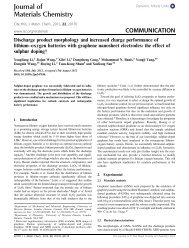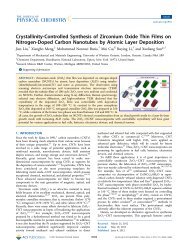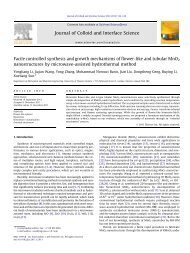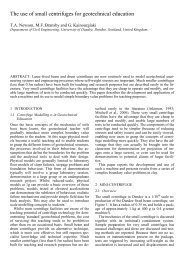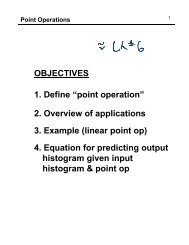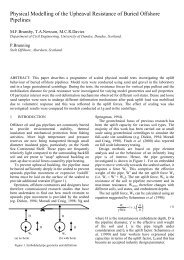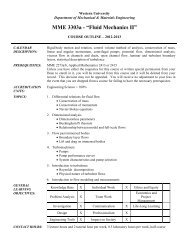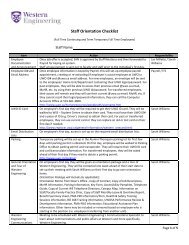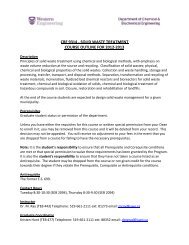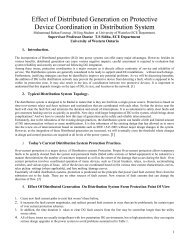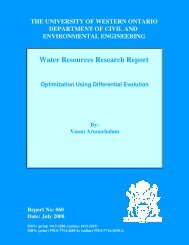Seismic Behavior of Gravel Drains and Compacted Sand Piles using ...
Seismic Behavior of Gravel Drains and Compacted Sand Piles using ...
Seismic Behavior of Gravel Drains and Compacted Sand Piles using ...
You also want an ePaper? Increase the reach of your titles
YUMPU automatically turns print PDFs into web optimized ePapers that Google loves.
Figure 22. Excess pore water pressure ratio isopiestic lines from numerical simulation <strong>of</strong> Test C.<br />
The isopiestic lines <strong>of</strong> the excess pore water pressure ratios, obtained from the numerical simulations, are depicted in<br />
Figures 20-22, <strong>and</strong> can be compared with their counterparts in Figures 11-13. Higher excess pore pressure ratios in test O<br />
<strong>and</strong> lower ones in tests G <strong>and</strong> C are the effects <strong>of</strong> the ground remediation. The numerical code applies the overburden<br />
pressure uniformly all over the surface, that's why the contours are not the same shape as the actual ones in Figures 11-<br />
13, especially in tests O <strong>and</strong> C. However, in corresponding depths the computed excess pore water pressure ratios agreed<br />
very well with the actual ones in test O but in tests G <strong>and</strong> C they were much less than the real values. In addition the<br />
numerical code was not able to simulate the dilative response <strong>and</strong> the consequent negative excess pore pressure beneath<br />
the foundation in test C. Besides the pore pressure reduction capability <strong>of</strong> the gravel drains was expressed by the<br />
numerical simulation.<br />
CONCLUSIONS<br />
A series <strong>of</strong> 1g shaking table tests were carried out to evaluate the performance <strong>of</strong> two common ground improvement<br />
techniques, gravel drains <strong>and</strong> s<strong>and</strong> compacted piles. For comparison a test with no improvement was also performed to<br />
compare the behaviors. Following the experimental work, these techniques were modeled with a finite element code.<br />
The experiments presented that the improvement provided by the dynamic compaction method not only reduces the<br />
excess pore pressure, but also the stiffer compacted s<strong>and</strong> piles provided higher overall foundation shear strength <strong>and</strong><br />
bearing capacity, preventing settlements better than gravel drains. Settlement was mainly due to migration <strong>of</strong> underlying<br />
foundation soil towards the free field (lateral spreading) in the tests with s<strong>and</strong> compacted piles. However with the gravel<br />
drains, the settlement was considerably raised due to the loss <strong>of</strong> shear strength <strong>and</strong> punching attained by the shaking<br />
process. Since gravel is a frictional material possessing negligible cohesion, confining pressure applied by the soil is <strong>of</strong><br />
paramount importance. Sufficient vertical stress or confining pressure might be required to engage the full reinforcing<br />
effect <strong>of</strong> the gravel drains. This confinement can be obtained with the weight <strong>of</strong> the structure <strong>and</strong> method <strong>of</strong> installation.<br />
The installation process should embed the drains tightly within the soil matrix, while preventing mixing <strong>of</strong> the in-situ<br />
s<strong>of</strong>t soil with the drain material. Such contamination not only compromises the strength <strong>of</strong> the columns, but also reduces<br />
their drainage capacity. Furthermore it was observed that the intensity <strong>of</strong> shaking was enough to produce liquefaction,<br />
however the excess pore pressure ratio never reached 100% under the center <strong>and</strong> edge <strong>of</strong> the foundation due to the static<br />
driving shear stress.<br />
In general, the test results suggest that compacted s<strong>and</strong> columns as stiffer elements are likely to be more viable solutions<br />
in mitigating liquefaction where the only possible mitigation benefit is from the stiffening stress concentration criterion.





